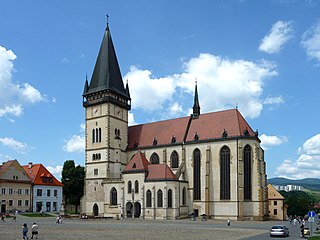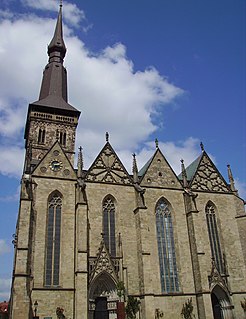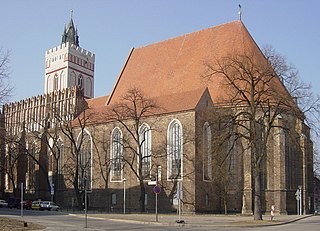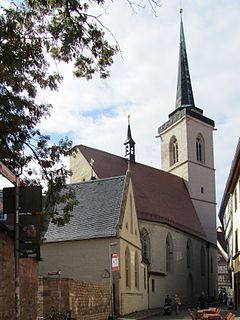

The Marienkirche (St. Mary's Church) in Prenzlau, Brandenburg, Germany, is the main Protestant parish church in the town, and is one of the most ornate churches of the Brick Gothic style in northern Germany. The church is a listed building.


The Marienkirche (St. Mary's Church) in Prenzlau, Brandenburg, Germany, is the main Protestant parish church in the town, and is one of the most ornate churches of the Brick Gothic style in northern Germany. The church is a listed building.



The predecessor building was built from 1235 to 1250 as a three-nave fieldstone hall church with a two-bay nave, a little wider transept and an indented straight choir. After the middle of the 13th century, the still preserved two-tower west building was added to this structure. [1]
From 1289 to 1340, the new church was built as a three-aisled Gothic hall church in the brick Gothic style, incorporating the western part of the predecessor building of fieldstone masonry. The spacious church with seven baies is 56 metres long, 26 metres wide and 22 metres high; the ridge of the roof is now 43 metres high. It was built in two sections, the boundary of which runs by the stair towers. It has a relatively flat, apsidal east end for each nave.
In the 14th and 15th centuries, the additions of the St. Christopher's Chapel with a show gable and the two-nave, three-bay St. Margaret's Chapel with a polygonal end on the south side were added. The ribbed vault of the Margareten Chapel was preserved. A two-storey porch adjoins to the west. On the north side, a porch crowned by a tracery gable in the style of Hinrich Brunsberg was built.
The magnificent eastern façade is considered "unique" in brick Gothic style because of its sophisticated construction; its individual forms are modelled on the Fassadenrisse F of the Cologne Cathedral. [1] The flat gable stands above the east end of the three naves. The apses are therefore only slightly developed with two polygon sides in the side aisles and three in the central nave. A unique feature is that the windows oriented towards the polygonal apses on the inside were fitted into the plane façade on the outside, resulting in sloping window reveals.
At 22 metres, the gable is as high as the vertical choir wall. The six buttresses end in ornamental pinnacless. A window-like design with bar and traceries made of red and black glazed stones, with gables and friezes.
The outer side walls are divided by the four-part windows and the multiple stepped buttresses. Protruding over the eaves above a tracery frieze and between fial pilars is a transparent wreath of openwork lashings. A panel frieze with plant motifs runs along the four west joches of the south side.
The northern porch from the beginning of the 15th century has a three-part Wimperg gable in the Brunsberg style. The large five-stepped west portal has fillets and round bars in the steps. Above it, towards the central nave, is a round window. A richly designed portal is on the north side, another on the south side.

The lower floors of the west building, made of fieldstone, are articulated with corner pilasters and flat fascias. In the 14th century, three brick storeys were added to the towers of the original west building, and the central section was given two brick storeys. The north tower, 68 metres high, is topped by a gable roof in an east–west direction between two Renaissance architecture gables. 234 steps lead to the Türmerstube .
The completion of the south tower, 64 metres high, took place in 1776. Since 1972, it too has had a gable roof like the north tower, but without the 4-metre-high plinth. Two clocks were installed in the upper storey.
The upper storeys of the towers are more richly articulated with 14th-century pointed-arch blende and have high pointed-arch sound openings with simple tracery in the bell storeys. Despite the inclusion of the older parts of the wall of the predecessor building and the fragmentary tower ends, the west building has a distinctly monumental effect that is comparable with the high and late Gothic parish churches in Wismar and Stralsund.
In the spacious, austerely kept interior, the cross ribbed vault with intervening separating arch was supported by the twelve richly designed, cruciform piers; the four frontal pier projections have strong Three-quarter round services (templates). The side walls have circumferential plinth zones with two pointed-arched diaphragms per bay. Above this is a walkway. The slender tracery windows are mostly in four parts. The window tracery was changed during the restorations; the tracery of the three eastern windows on the south side could be considered original. The finely profiled High Gothic interior of the church occupies a certain exceptional position within the Brick Gothic style due to these very characteristics.
In front of the high altar was the tombstone [2] of Adelheid von der Asseburg († 1588), wife of Leonhard von Kotze, her portrait was in the right aisle. From 1581 to 1918, on the basis of a bequest, the bell was rung daily in the hour of her death at about two o'clock in the afternoon, until her endowment lapsed in the course of inflation; thus her memory remained alive in the parish. [3]
The circular window in the west, designed by Johannes Schreiter in 1995, combines the motif of the cross with colours and abstract forms that are intended to recall suffering, destruction, war and reconstruction.
The later court and cathedral preacher in Berlin, Johannes Fleck (1559–1628), worked as inspector (superintendent) at St Mary's Church in Prenzlau from 1596 to 1601.
During the Thirty Years' War, the body of the Swedish king Gustavus Adolphus of Sweden was kept in the north tower of St Mary's Church from 20 to 22 December 1632 as part of the transfer to Sweden.
In 1844/46, the interior of the church was extensively remodelled in the Neo-Gothic style by Eduard Knoblauch. Between 1878 and 1887, the exterior of the church was restored.
At the liberation of Prenzlau at the end of World War II by the Red Army on 27/28 April 1945, [4] the church burnt out with the massive roof truss of the nave and the vault collapsed; the enclosing walls and pillared arcades remained. In 1947, the gables of the north tower end, which had survived until then, collapsed. In 1949/50, the east gable was secured against collapse. [5] The reconstruction began in 1970, in 1972 the assembly of the roof truss, in 1973/74 the covering of the gable roof with copper plates as well as the repair of the staircase in the towers and the covering of the Margaret Chapel. From 1972 to 1988, the tower facades were repaired, the interiors of the south chapels were refurbished and the east gable and the east south facade were restored. In 1982, the north tower was completed, in 1984 the roof of the south tower, in 1988 the roofing and vaulting of the north porch and in 1990/91 the renovation of the façade. In 1990, a celebration was held for what had been achieved. The modern rose window with the theme Destruction and Reconstruction was realised by the glass artist Johannes Schreiter and handed over in 1995. In 1997, the altar was put up again.
Donations have been collected since 2013 for the reconstruction of the vaults and the gallery. In 2014, the budget of the State Minister for Culture of Brandenburg provided additional funds of 3.24 million euros for this purpose. [6] Since August 2015, the tenders and preparations for the reconstruction of the vaults have been undertaken. [7] From June 2018 until the end of 2020, the reconstruction of the vaults was planned. [8] [9] After initial delays, the construction work went according to plan. By April 2019, three of the seven bays had been completed, and by August 2019, five. [10] The reconstruction of the vaults was completed as planned in 2020. [11] On 14 January 2020, the last keystone of the vaults was set. On 17 May 2020, a service was held to mark the completion of the vaults in the neighbouring church of St Jacob. After completion of the work on the gallery and the organ, the restored interior of Marienkirche will be used for services again in autumn 2021. [12]

The late Gothic high altar was created around 1512 by the Master of the Prenzlau high altar in Lübeck. It survived the destruction of the church because it had been walled in and was placed in the Dominican Monastery Prenzlau until 1991. After a theft in that year, a large part of the stolen figures could be returned, but some figures are still missing today. Afterwards, the figures and reliefs were restored, exposing the original version, and arranged in a reconstructive structure. [13]
The shrine depicts a Woman of the Apocalypse originally surrounded by four angels, only two of which have survived. To the side of this are four smaller saints arranged in two rows. In the wings, the apostles are depicted in two rows, of which only nine are preserved. In the predella is a broad, vivid relief of the Adoration of the Magi. The once very rich sprinkling shows the depictions of Christ with the flag of victory, Saint George and Saint Maurice and a crowning Madonna in a halo. [1]
In 1567/68 the first pipe organ was installed. In 1743, a new organ with 2 manuals and about 20 stops by Johann Michael Röder followed. In 1847, after the remodelling of the church, the new organ with 2 manuals and 33 stops by Carl August Buchholz from Berlin could be inaugurated. In 1945, it was destroyed and has not yet been replaced. After the restoration of the vaults by 2020, the installation of a historic organ by William Hill & Son from 1904 is also planned by 2021, which will be transported here as a donation from the former West Parish Church Kilbarchan in Scotland. [14]
In 1867, Ernst Flügel organist and gymnasium singing teacher in Prenzlau was also active as pianist and organist at the Marienkirche until 1879.

The central gate tower and Marienkirche on the Marktberg together form Prenzlau's best-known town view. Until its destruction in 1945, a row of mostly two-storey houses stood in front of the east view of the church, giving the scale for Marienkirche and thus increasing the monumentality of the east gable. [15]
In front of the church, on the south-west side, is the Luther monument, modelled on the Original in Worms by Ernst Rietschel, which was created in 1903.
The Marienkirche is the main Protestant parish church of the parish with the daughter churches of St. Nicolai, St. Jacobi and St. Sabini and twelve other parishes. It is a member of the Prenzlau church district with its twelve parishes. The church district is led by a superintendent and the district church council.
The preservation of the church is the responsibility of the "Förderverein Marienkirche Prenzlau".

St. Mary's Church, or formally the Basilica of the Assumption of the Blessed Virgin Mary, is a Brick Gothic Catholic church located in central Gdańsk, Poland. With its volume between 185,000 m3 and 190,000 m3 it is currently one of the two or three largest brick churches in the world. Only San Petronio Basilica in Bologna, comprising 258,000 m3 is larger, Munich Frauenkirche and Ulm Minster also comprise 185,000 to 190,000 m3.

Strasbourg Cathedral or the Cathedral of Our Lady of Strasbourg, also known as Strasbourg Minster, is a Catholic cathedral in Strasbourg, Alsace, France. Although considerable parts of it are still in Romanesque architecture, it is widely considered to be among the finest examples of Rayonnant Gothic architecture. Architect Erwin von Steinbach is credited for major contributions from 1277 to his death in 1318, and beyond through his son Johannes von Steinbach, and his grandson Gerlach von Steinbach, who succeeded him as chief architects. The Steinbachs's plans for the completion of the cathedral were not followed through by the chief architects who took over after them, and instead of the originally envisioned two spires, a single, octagonal tower with an elongated, octagonal crowning was built on the northern side of the west facade by master Ulrich von Ensingen and his successor, Johannes Hültz. The construction of the cathedral, which had started in the year 1015 and had been relaunched in 1190, was finished in 1439.

The Lübeck Marienkirche was built between 1265 and 1351. The Lübeck market and main parish church is located on the highest point of Lübeck's old town island, is part of the Lübeck Old Town UNESCO World Heritage Site and one of the largest brick churches. It is referred to as the "mother church of brick Gothic" and is considered a major work of church building in the Baltic Sea region. St. Marien belongs to the Evangelical Lutheran Church in Northern Germany.

Bremen Cathedral, dedicated to St. Peter, is a church situated in the market square in the center of Bremen. The cathedral belongs to the Bremian Evangelical Church, a member of the Protestant umbrella organization named Evangelical Church in Germany. It is the previous cathedral of the former Prince-Archbishopric of Bremen. Since 1973, it is protected by the monument protection act.

Howden Minster is a large Grade I listed Church of England church in the Diocese of York. It is located in Howden, East Riding of Yorkshire, England. It is one of the largest churches in the East Riding of Yorkshire. It is dedicated to St Peter and St Paul and it is therefore properly known as 'the Minster Church of St Peter and St Paul'. Its Grade I listed status also includes the Chapter House.

The cathedral of St. Bartholomew is a Gothic church located on the Main Square in Plzeň, Czech Republic. It was probably established together with the city around the year 1295. The church became a cathedral in 1993, when the Pilsner diocese was created. It was included on the list of National cultural monuments of the Czech Republic in 1995.

St Mary's Church is in St Mary's Street, Crewe, Cheshire, England. It is an active Roman Catholic parish church in the diocese of Shrewsbury. The church is recorded in the National Heritage List for England as a designated Grade II listed building.

Divi Blasii is a Gothic church in the Thuringian town of Mühlhausen, central Germany. Besides St Mary's, it is one of Mühlhausen's two principal churches. Divi Blasii is a three-nave, cruciform hall church, situated on the Untermarkt in the historical centre of the town. The elaborately designed display façade with tracery, pinnacles and a wheel window on the north side is located on an old trade route. Today, Divi Blasii is the central parish church of the Lutheran parish of Mühlhausen within the Protestant Church in Central Germany.

St. Mary's Church in Marienberg in the German state of Saxony is an Evangelical-Lutheran church in the southeast of the county of Erzgebirgskreis. It is the most recent of the three Ore Mountain Late Gothic hall churches.

Predigerkirche is one of the four main churches of the old town of Zürich, Switzerland, besides Fraumünster, Grossmünster and St. Peter. First built in 1231 AD as a Romanesque church of the then Dominican Predigerkloster, the Basilica was converted in the first half of the 14th century, the choir between 1308 and 1350 rebuilt, and a for that time unusual high bell tower was built, regarded as the highest Gothic edifice in Zürich.

St. Procopius Church is a Roman Catholic church in Žďár nad Sázavou in the Czech Republic. It is protected as a cultural monument.

St. Michael's Church in Jircháře, Prague - New Town near the National Theatre, specifically the New Town street, which is called v Jirchářích. It is the seat of Czech, Slovak and English congregation of the Evangelical Church of the Augsburg Confession in the Czech Republic. Its architectural style is not uniform due to alterations in different periods and styles. It is protected as a cultural monument of the Czech Republic.

Basilica of St Giles in Bardejov, Slovakia, is a Gothic sacral building, which is situated in the northern part of the Town-Hall square. Bardejov is located in the larger area of town Prešov in the region called Šariš.

St. Marien is a Lutheran parish and market church in Osnabrück, Germany. It is one of the most artistically and historically significant buildings in the North German city. A previous Romanesque church was mentioned in records as early as 1177. However, the history of the church's construction began some time before it was first mentioned in writing. Archaeological traces suggest the existence of a predecessor building in the 10th century. Construction of the Gothic hall church which exists today started in the 13th century and was completed between 1430 and 1440.

Marienkirche is a church in Dortmund, North Rhine-Westphalia state, Germany, located in the inner city. Since the Reformation, it has been a Lutheran parish church of St. Marien. The church was destroyed in World War II, but rebuilt. It also serves as a concert venue for sacred music.

The Marienkirche is a Protestant church in Frankfurt (Oder) in Germany. It was formerly the city's main parish church and was built over more than 250 years, during the Middle Ages.

St. Nikolai, Greifswald, dedicated to Saint Nicholas, the patron saint of seafarers and merchants, is a Brick Gothic church located in the western part of the centre of Greifswald. It was the main church and seat of the bishop of the Pomeranian Evangelical Church.

St. Castulus church is a Gothic church with Romanesque and Baroque elements. It is located on the Castulus square, in Old town near Convent of Saint Agnes. It is the only church in the Czech Republic consecrated to Saint Castulus.

Saint Giles Church is a church on the Kostelní Square in the centre of Nymburk in the Central Bohemian Region of the Czech Republic. The church was built probably in the 13th century, as well as the surrounding town, however, there are no preserved sources confirming its origins. The church is a three nave basilica with a long chancel and a tower in the front. There was also a second tower, but now there are only its remains.

All Saints' Church in the city of Erfurt in Thuringia, Germany, is a small Roman Catholic church building dating from the 12th to 14th century. The Gothic hall church is located at the fork of Allerheiligenstraße and Marktstraße in the historical centre of Erfurt. It has an irregular floor plan and, at 53 metres (174 ft), the highest church tower in the old part of the city. Since 2007, it has been the first Roman Catholic church in central Germany to house a columbarium.
| Wikimedia Commons has media related to Marienkirche (Prenzlau) . |